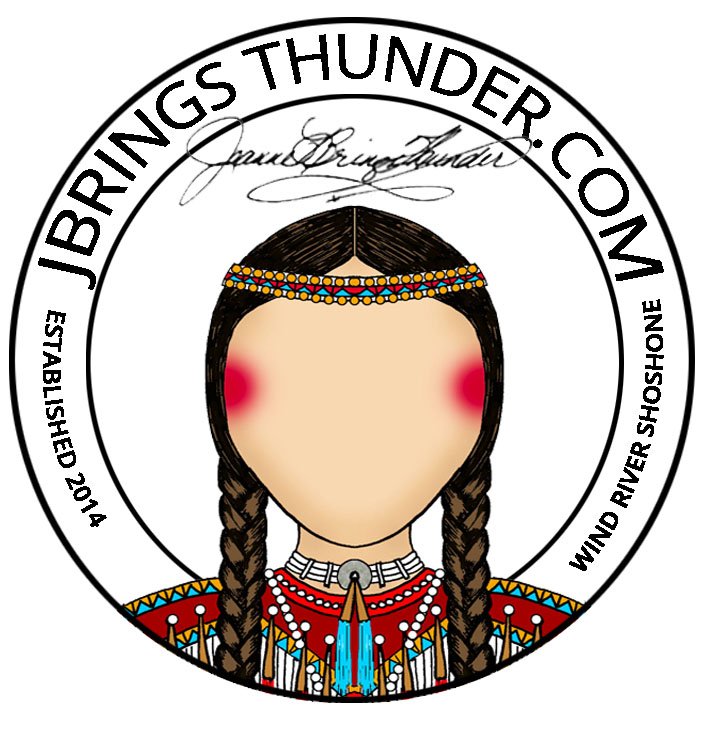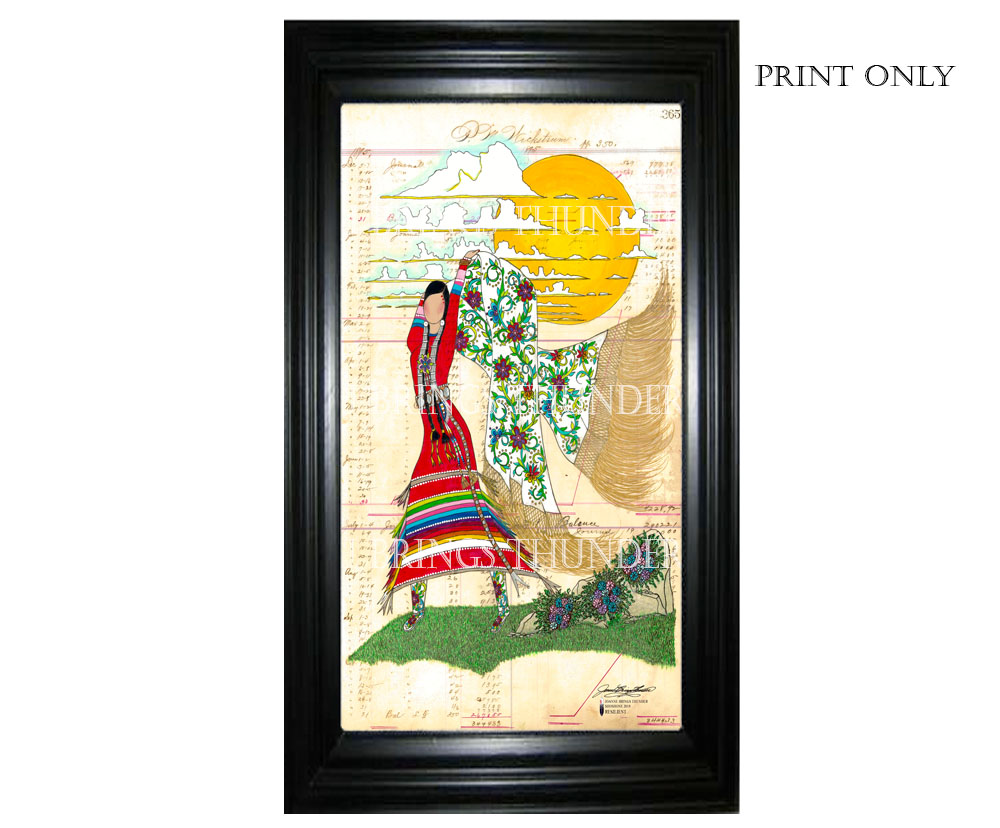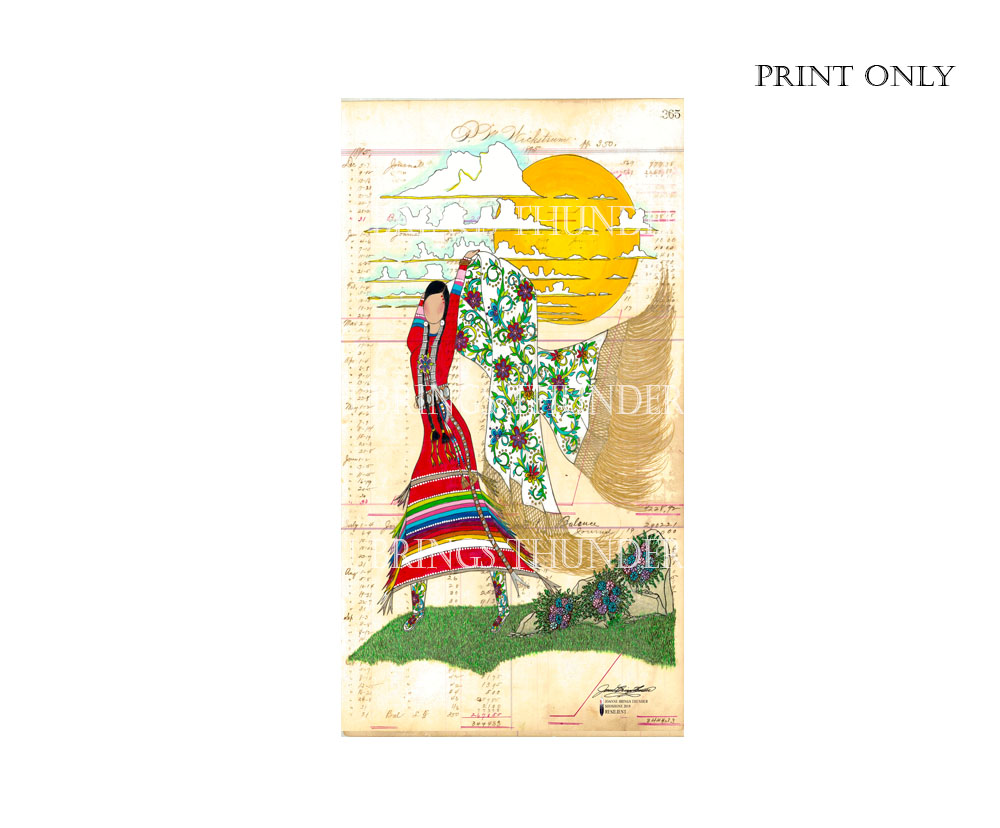Deer Woman - Sogo Dee Hee Wypuh




Deer Woman - Sogo Dee Hee Wypuh
***PRINT ONLY***
Deer Woman - Sogo Dee Hee Wypuh
Mixed Media : Ledger Paper, Acrylic, Ink
Dimensions: 11”x17”
Original: 1810 Ledger Paper
By: Joanne Brings Thunder - 2023
Deer Woman – Sogo Dee Hee Wypuh: may appear as an old woman, a beautiful young woman, a deer, or some mix thereof. She is a shapeshifter, and like many shapeshifters has a trickster element to her story. Often her form is of a beautiful human woman that does not have human feet, but cloven hooves.
Many of her myths are unknown and untold, kept within our native communities. What I do know of her, however, shows she is related to fertility, women, children, and revenge against men and the wicked.
Deer Woman is one of the Little People: among the Wind River Shoshone they are called Ninamby The function of the Little People is similar to the function of the fairies and gnomes of European cultures. There are stories we were told when we were younger — that the Little People would come from the earth and swallow us up if we weren’t good. However, as with people there is both good and bad ninambies and various stories exist.
Amongst my people and others, Deer Woman was originally a shape-shifting woman who became a deer after she had been raped and in some accounts murdered. She was found dead with a deer lying next to her perhaps it was a comfort to her in her last moments. Today, she remains a symbol of freedom and strength, she represents hope for many women facing abuse.
The Deer Woman spirit teaches us that marriage and family life within the community are important and these relationships cannot be entered into lightly. Her tales are morality narratives: she teaches us that the misuse of sexual power is a transgression that will end in madness and death to the one that victimizes people.
Deer Woman is known for being playful and mischievous, as well as curious about mortal human activities. She loves to dance and sing. It is believed she enjoys playing tricks on people.
In addition to being a modern day symbol of feminine strength, Deer Woman is also a protector of women and children. She is a guardian spirit, and she watches over the safety of her family members. She is also a healer, and she helps women and children recover from physical, emotional trauma and abuse.
The Deer Woman is making a resurgence today in part due to the disproportionately high rates of Native women being sexually assaulted or dealing with domestic violence. She is becoming a symbol of survival and resilience to women besieged by such violence.
She is a guardian spirit for women and children, and enacts revenge against anyone who harms those she protects.
Eastern Shoshone belief is that the Deer woman actually steals the souls of men so they will be lost their whole lives should they abuse and victimize a woman or her children. She also has been known to abduct abusive women, never to be seen again.
If you encounter the Sogo Dee Hee Wypuh (deer woman), it is said that she can be banished with tobacco and ceremony. Another way to break her hold is to look at her feet. Once you recognize her as the Sogo Dee Hee Wypuh, she runs away.
As with most tricksters, however, the best way to avoid being ensnared by an angry Deer woman spirit is to be good. Don’t be promiscuous, don’t cheat, and don’t hurt or abuse women or children.
The Deer Woman is most well known in and around the Western United States and the Pacific Northwest. Deer woman stories have been documented by many tribes located in these areas.
Deer Woman is an apparition of female sexuality, appearing as the wildest aspect of femininity. She is associated with fertility, and has been described as being seductive, protective and dangerous.
In addition to the sexualized version of herself, the Deer Woman is also known as a spirit of transformation, a warning of danger, or a guide to help humans find their way back to a path of righteousness.
She is a symbol of powerful feminine in her more wrathful stories. A woman harmed by a man and ready to get revenge on any man who happens upon her with ill intentions. I know many women who can relate to this archetype, and her powerful energy is worthy of reverence and respect.
Her stories associated with fertility are less known in the modern day, but these stories can’t be divorced from her role as protector of women and children. She is a mother figure after all and for this reason, capable of both great violence and great tenderness.
Ledger Art History
This genre, often called Ledger Art, represents a transitional form of Plains Indian artistry corresponding to the forced reduction of Plains tribes to government reservations, roughly between 1860 and 1900. Due to the destruction of the buffalo herds and other game animals of the Great Plains by Anglo-Americans during and after the Civil War, painting on buffalo hide gave way to works on paper, muslin, canvas, and occasionally commercially prepared cow or buffalo hides.
Changes in the content of pictographic art, the rapid adjustment of Plains artists to the relatively small size of a sheet of ledger paper, and the wealth of detail possible with new coloring materials, marks Plains ledger drawings as a new form of Native American art. As such, ledger painting portrays a transitional expression of art and material culture that links traditional (pre-reservation) Plains painting to the Plains and Pueblo Indian painting styles that emerged during the 1920s in Indian schools in Oklahoma and New Mexico.
Beginning in the early 1860s, Plains Indian men adapted their representational style of painting to paper in the form of accountants ledger books. Traditional paints and bone and stick brushes used to paint on hide gave way to new implements such as colored pencils, crayon, and occasionally water color paints. Plains artists acquired paper and new drawing materials in trade, or as booty after a military engagement, or from a raid. Initially, the content of ledger drawings continued the tradition of depicting of military exploits and important acts of personal heroism already established in representational painting on buffalo hides and animal skins. As the US government implemented the forced relocation of the Plains peoples to reservations, for all practical purposes completed by the end of the 1870s, Plains artists added scenes of ceremony and daily life from before the reservation to the repertoire of their artwork, reflecting the social and cultural changes brought by life on the reservation within the larger context of forced assimilation.
Copyright
All content including the presentation thereof on this web site is the property of Joanne Brings Thunder and protected by U.S. and international copyright laws. You may not copy, reproduce, distribute, transmit, modify, create derivative works, or in any other way exploit any part of copyrighted material without the prior written permission from Joanne Brings Thunder.
***PRINT ONLY***
Deer Woman - Sogo Dee Hee Wypuh
Mixed Media : Ledger Paper, Acrylic, Ink
Dimensions: 11”x17”
Original: 1810 Ledger Paper
By: Joanne Brings Thunder - 2023
Deer Woman – Sogo Dee Hee Wypuh: may appear as an old woman, a beautiful young woman, a deer, or some mix thereof. She is a shapeshifter, and like many shapeshifters has a trickster element to her story. Often her form is of a beautiful human woman that does not have human feet, but cloven hooves.
Many of her myths are unknown and untold, kept within our native communities. What I do know of her, however, shows she is related to fertility, women, children, and revenge against men and the wicked.
Deer Woman is one of the Little People: among the Wind River Shoshone they are called Ninamby The function of the Little People is similar to the function of the fairies and gnomes of European cultures. There are stories we were told when we were younger — that the Little People would come from the earth and swallow us up if we weren’t good. However, as with people there is both good and bad ninambies and various stories exist.
Amongst my people and others, Deer Woman was originally a shape-shifting woman who became a deer after she had been raped and in some accounts murdered. She was found dead with a deer lying next to her perhaps it was a comfort to her in her last moments. Today, she remains a symbol of freedom and strength, she represents hope for many women facing abuse.
The Deer Woman spirit teaches us that marriage and family life within the community are important and these relationships cannot be entered into lightly. Her tales are morality narratives: she teaches us that the misuse of sexual power is a transgression that will end in madness and death to the one that victimizes people.
Deer Woman is known for being playful and mischievous, as well as curious about mortal human activities. She loves to dance and sing. It is believed she enjoys playing tricks on people.
In addition to being a modern day symbol of feminine strength, Deer Woman is also a protector of women and children. She is a guardian spirit, and she watches over the safety of her family members. She is also a healer, and she helps women and children recover from physical, emotional trauma and abuse.
The Deer Woman is making a resurgence today in part due to the disproportionately high rates of Native women being sexually assaulted or dealing with domestic violence. She is becoming a symbol of survival and resilience to women besieged by such violence.
She is a guardian spirit for women and children, and enacts revenge against anyone who harms those she protects.
Eastern Shoshone belief is that the Deer woman actually steals the souls of men so they will be lost their whole lives should they abuse and victimize a woman or her children. She also has been known to abduct abusive women, never to be seen again.
If you encounter the Sogo Dee Hee Wypuh (deer woman), it is said that she can be banished with tobacco and ceremony. Another way to break her hold is to look at her feet. Once you recognize her as the Sogo Dee Hee Wypuh, she runs away.
As with most tricksters, however, the best way to avoid being ensnared by an angry Deer woman spirit is to be good. Don’t be promiscuous, don’t cheat, and don’t hurt or abuse women or children.
The Deer Woman is most well known in and around the Western United States and the Pacific Northwest. Deer woman stories have been documented by many tribes located in these areas.
Deer Woman is an apparition of female sexuality, appearing as the wildest aspect of femininity. She is associated with fertility, and has been described as being seductive, protective and dangerous.
In addition to the sexualized version of herself, the Deer Woman is also known as a spirit of transformation, a warning of danger, or a guide to help humans find their way back to a path of righteousness.
She is a symbol of powerful feminine in her more wrathful stories. A woman harmed by a man and ready to get revenge on any man who happens upon her with ill intentions. I know many women who can relate to this archetype, and her powerful energy is worthy of reverence and respect.
Her stories associated with fertility are less known in the modern day, but these stories can’t be divorced from her role as protector of women and children. She is a mother figure after all and for this reason, capable of both great violence and great tenderness.
Ledger Art History
This genre, often called Ledger Art, represents a transitional form of Plains Indian artistry corresponding to the forced reduction of Plains tribes to government reservations, roughly between 1860 and 1900. Due to the destruction of the buffalo herds and other game animals of the Great Plains by Anglo-Americans during and after the Civil War, painting on buffalo hide gave way to works on paper, muslin, canvas, and occasionally commercially prepared cow or buffalo hides.
Changes in the content of pictographic art, the rapid adjustment of Plains artists to the relatively small size of a sheet of ledger paper, and the wealth of detail possible with new coloring materials, marks Plains ledger drawings as a new form of Native American art. As such, ledger painting portrays a transitional expression of art and material culture that links traditional (pre-reservation) Plains painting to the Plains and Pueblo Indian painting styles that emerged during the 1920s in Indian schools in Oklahoma and New Mexico.
Beginning in the early 1860s, Plains Indian men adapted their representational style of painting to paper in the form of accountants ledger books. Traditional paints and bone and stick brushes used to paint on hide gave way to new implements such as colored pencils, crayon, and occasionally water color paints. Plains artists acquired paper and new drawing materials in trade, or as booty after a military engagement, or from a raid. Initially, the content of ledger drawings continued the tradition of depicting of military exploits and important acts of personal heroism already established in representational painting on buffalo hides and animal skins. As the US government implemented the forced relocation of the Plains peoples to reservations, for all practical purposes completed by the end of the 1870s, Plains artists added scenes of ceremony and daily life from before the reservation to the repertoire of their artwork, reflecting the social and cultural changes brought by life on the reservation within the larger context of forced assimilation.
Copyright
All content including the presentation thereof on this web site is the property of Joanne Brings Thunder and protected by U.S. and international copyright laws. You may not copy, reproduce, distribute, transmit, modify, create derivative works, or in any other way exploit any part of copyrighted material without the prior written permission from Joanne Brings Thunder.










